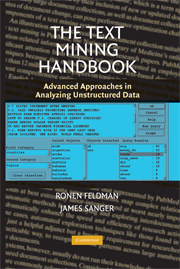Book contents
- Frontmatter
- Contents
- Preface
- I Introduction to Text Mining
- II Core Text Mining Operations
- III Text Mining Preprocessing Techniques
- IV Categorization
- V Clustering
- VI Information Extraction
- VII Probabilistic Models for Information Extraction
- VIII Preprocessing Applications Using Probabilistic and Hybrid Approaches
- IX Presentation-Layer Considerations for Browsing and Query Refinement
- X Visualization Approaches
- XI Link Analysis
- XII Text Mining Applications
- Appendix A DIAL: A Dedicated Information Extraction Language for Text Mining
- Bibliography
- Index
IV - Categorization
Published online by Cambridge University Press: 08 August 2009
- Frontmatter
- Contents
- Preface
- I Introduction to Text Mining
- II Core Text Mining Operations
- III Text Mining Preprocessing Techniques
- IV Categorization
- V Clustering
- VI Information Extraction
- VII Probabilistic Models for Information Extraction
- VIII Preprocessing Applications Using Probabilistic and Hybrid Approaches
- IX Presentation-Layer Considerations for Browsing and Query Refinement
- X Visualization Approaches
- XI Link Analysis
- XII Text Mining Applications
- Appendix A DIAL: A Dedicated Information Extraction Language for Text Mining
- Bibliography
- Index
Summary
Probably the most common theme in analyzing complex data is the classification, or categorization, of elements. Described abstractly, the task is to classify a given data instance into a prespecified set of categories. Applied to the domain of document management, the task is known as text categorization (TC) – given a set of categories (subjects, topics) and a collection of text documents, the process of finding the correct topic (or topics) for each document.
The study of automated text categorization dates back to the early 1960s (Maron 1961). Then, its main projected use was for indexing scientific literature by means of controlled vocabulary. It was only in the 1990s that the field fully developed with the availability of ever increasing numbers of text documents in digital form and the necessity to organize them for easier use. Nowadays automated TC is applied in a variety of contexts – from the classical automatic or semiautomatic (interactive) indexing of texts to personalized commercials delivery, spam filtering, Web page categorization under hierarchical catalogues, automatic generation of metadata, detection of text genre, and many others.
As with many other artificial intelligence (AI) tasks, there are two main approaches to text categorization. The first is the knowledge engineering approach in which the expert's knowledge about the categories is directly encoded into the system either declaratively or in the form of procedural classification rules.
- Type
- Chapter
- Information
- The Text Mining HandbookAdvanced Approaches in Analyzing Unstructured Data, pp. 64 - 81Publisher: Cambridge University PressPrint publication year: 2006

